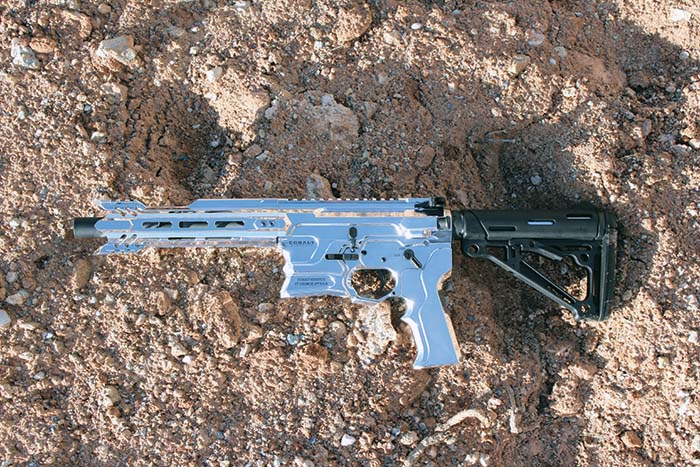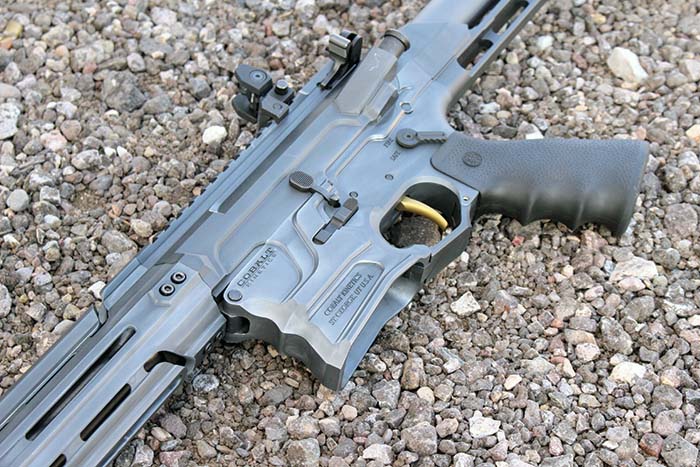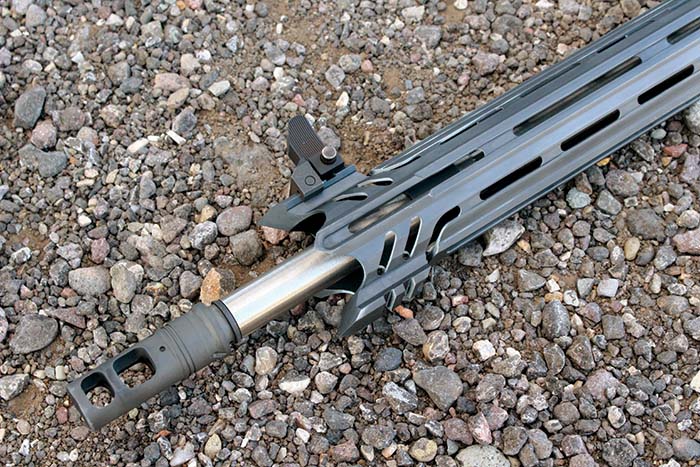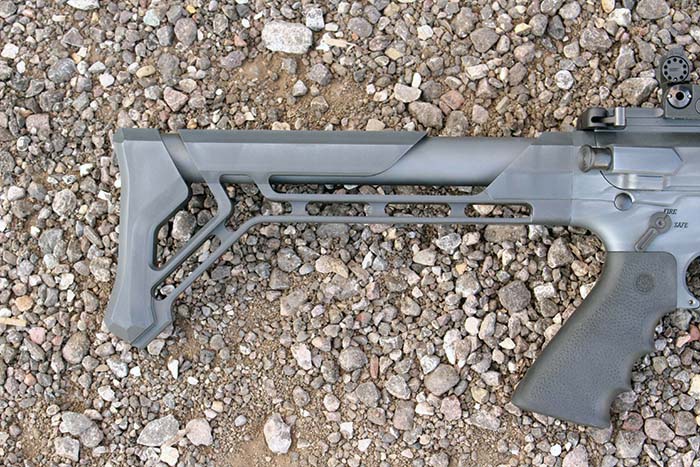By David Lake
Here is the unlikely success story about a new small arms manufacturer from the desert of Southern Utah. Cobalt Kinetics came from nothing; that is, the founder and partners involved in the inception of the company knew little to nothing about guns or how to make them, or how to sell them. All they really had was vision and motivation; usually enough to ensure success in anything. Cobalt began unencumbered by the financial burden that makes growing a new business difficult; the infrastructure to make this business venture possible came about at the snap of a finger. Free from the mundane struggles and growing pains of starting a new business, the men and women of Cobalt Kinetics were able to move forward at the speed of thought in pursuit of their endeavor. The company’s success was not without cost however. There was much hard work involved, to be sure. The people of Cobalt Kinetics will regale you with stories of 20 hour workdays and 7 day workweeks to get the thing started. Their greatest challenge, and highest achievement, and ultimately the key to their success was the cohesive working relationship among the staff. The machine operators, the executives, and everyone in between shared a common goal. Cobalt’s goal and vision was not to simply package another AR-15 but to create a better AR-15. Sure, the current staple of the Cobalt brand is indeed an AR-15 at its heart. But Small Arms Review was made to understand (and shown, unofficially) that Cobalt’s interpretation of the AR-15 is just a first step. Cobalt Kinetics is scheming to change the industry and they intend to make some waves.
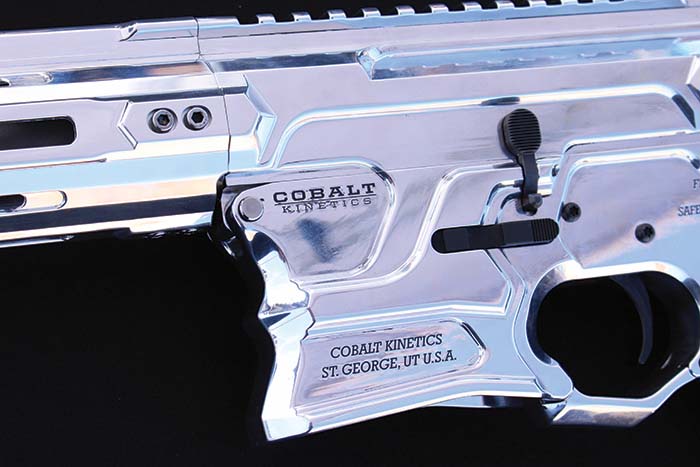
At first look, Cobalt’s flagship rifle, the BAMF (Billet Aluminum Modern Firearm) comes across as an abstract modern art masterpiece. It’s as if Alexander Calder and his contemporaries conspired to craft a rifle. Maybe the BAMF is where gothic architecture meets science fiction space film. This rifle’s shape is more art than engineering. During conception and design, the artist behind the gun was left to draIw and design as he wished (Cobalt really does employ an artist who in fact knows precious little about guns). Cobalt’s engineering team just had to fine tune the artwork until a gun could fit inside. Whatever the cause or effect of its marked appearance, believe that the BAMF is all business. Small Arms Review became aware of Cobalt’s plans in October of 2014. Cobalt expressed some very optimistic plans and goals for the future and direction of the company. They had nothing but a lower receiver and some drawings and, in no more than 10 weeks, Cobalt Kinetics managed to create a full line of rifles and unique features and amazing possibilities. SHOT Show 2015 was the official unveiling of Cobalt and its BAMF.
During its growth, the team at Cobalt never lost sight of the plan to produce a supreme quality AR-15. The internals and all working components are either sourced from top-shelf industry firms or created in-house at Cobalt Kinetics. The BAMF makes neither compromise nor concession for economy’s sake. No expense is spared, as long as that expense directly enhances the rifle’s performance or aesthetic. There are many practical rifles available to the consumer. There are many accurate rifles available to the competitor. There are many hard-working rifles available to the professional. There are beautiful rifles available to the collector. The BAMF is all of these; and available to everyone. The BAMF straddles the thin line that separates form from function. Nay, it erases that line and expresses plainly that form and function can coexist. The trend in small arms development today demands modularity and durability and the tastes of upcoming consumers demand style and exclusivity. Anyone with a background in mechanics or engineering will scoff at the allusion that you can have it all. For example, a Maserati is a work of art – it’s exquisitely sculpted by old-world craftsmen, but it can never run as long or be as reliable as a Toyota, which is built with gross robotic precision. And be sure that Toyota will never make anything as beautiful as the Maserati. So, maybe it’s true, in cars at least- you cannot have it all. But if you’re seeking an AR-15 rifle that is visually pleasing, and functionally superior, you are now in luck. As with all things art, everyone has their taste. If the BAMF does not please your eye, sorry, you should move on. There are plenty of boring, ordinary AR clones on the market.
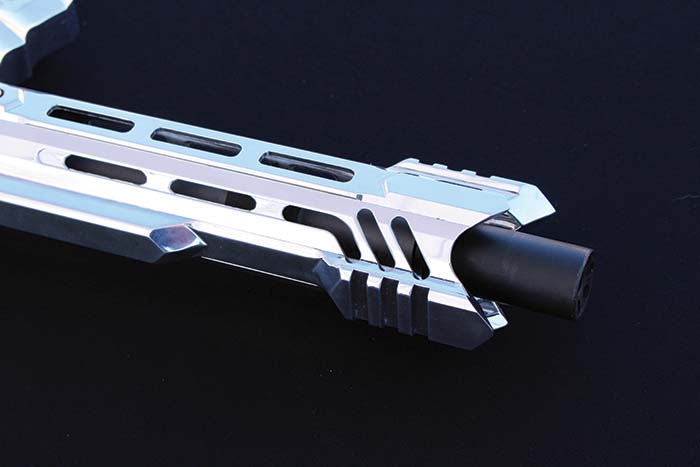
When looking over the Cobalt BAMF, it’s easy to miss the mechanical genius inside and the beauty is in the details. The BAMF has a totally new and unique operating feature coined the “DD” (double “d”) and it is an ambidextrous forward assist and simultaneous bolt release integrated and incorporated into the upper receiver. The conventional forward assist is mirrored on both sides of the upper. The forward assist buttons have been linked through a secret mechanism in the upper receiver, so each button actuates the other. And this symmetrical forward assist has been linked to the bolt catch in the lower receiver. There are no major changes to the basic function of the AR-15. The system does not require a special bolt group or any modification to any component. It’s a big step forward, without the usual step back. The Double-D offers the user fast (and safe) actuation of the bolt catch after the bolt has locked to the rear on an empty magazine. Once a full mag has been seated into the rifle, the thumb of the strong hand just bumps one of the forward assist buttons to send the bolt home. The result is equal to the extended levers that snake down through the trigger guard with claims to speed up the operation of a rifle. But these devices come with their own kinds of potential problems. Some shooters have been observed to discharge a rifle while attempting to actuate the control lever in the trigger guard. It is the belief, in fact, of every gun-handling professional that the finger should only ever enter the trigger guard with immediate intent to fire the gun. The placement of other optional control surfaces proximal to the bang switch is just a bad idea. The Double-D mechanism serves the same purpose, without exposing the shooter to the possibility of an accident. Also, the forward assist is a familiar part on the AR-15 and a standard part of the AR’s manual of arms, so there’s no need to re-learn or familiarize one’s self with the placement of a new control surface to
operate the rifle.
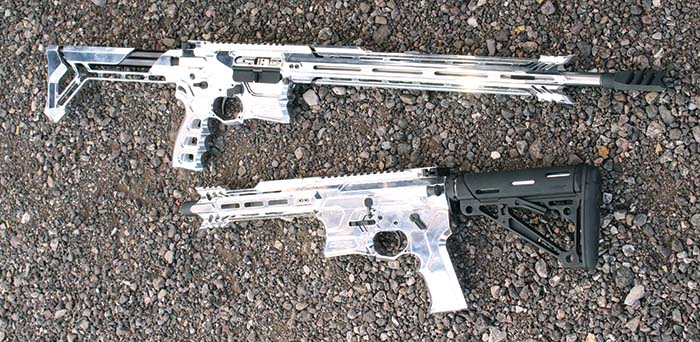
Cobalt Kinetics would not rest on their laurels when it comes to proving the rifle. Good looks will only get you so far today so they employed a team of men whose daily job requirement was to wear out and destroy the BAMF. For weeks this team loaded magazines and emptied those magazines as efficiently as possible; by pulling the trigger on a rifle. Cobalt burned off over 80,000 rounds of 5.56 NATO through 4 rifles in the name of learning, by way of abusive testing. Two of these rifles have cycled over 30,000 rounds each. Failures happened, sure, but not like one would expect. A gas tube burst as it approached a temperature so high all tensile strength had been lost. One barrel cooked off its ceramic coating. Another barrel changed color turning from bright stainless to purple and brown. Extractor and ejector springs flattened out after taking a set and losing tension from extreme heat exposure. One buffer’s urethane bumper shattered from fatigue. Smoke escaped from all the cracks and gaps as oil and lock-tite were boiled off. The pair of 30,000 round rifles, however, kept the same bolt groups and trigger mechanisms throughout testing. The structural members; the receivers, forearms, stocks and buffer tubes all lasted the duration with no demonstrable wear, failure or other deficiency (the barrels lasted through the entire test, but with little remaining accuracy potential). This month long exercise showed a wanton indifference to the ammunition shortage we’re experiencing today. But what was learned from it is the important part.
Cobalt can authoritatively say what works and what doesn’t. You can wholeheartedly believe that the Cobalt BAMF is built to perform based on that.

The lessons learned in the testing phase have been applied to the production rifle. Cobalt’s rifles are held to a standard of perfection. The receiver’s internal tolerances and surface finish are tightly controlled to a far greater degree than Mil-Spec demands. The receivers are tracked and recorded through every step of the manufacturing process; from the delivery of the bar stock to the final assembly of a complete rifle. The receivers are inspected for tolerance, function and appearance at multiple stages throughout the process. Upper to lower fit are held at between zero and two thousandths of an inch. The magazine wells are cut by the slowest, but most precise means – wire EDM. The final assembly process is taken on with the solemnity of a religious rite. One technician is tasked with hand selecting components for a rifle, based on individual fit. The receiver sets are assembled and a finger is passed over the mating edges to ensure perfect fit. The buffer tubes and receiver extensions are honed and polished inside. The buffer springs are polished as well. Safety selector barrels and takedown and pivot pins are sourced from the best firms in the industry, but are still checked with a micrometer before assembly to ensure it fits ideally in the prescribed hole, which has also been checked with a precision pin gauge just before the moment of assembly. Every screw is torqued to a prescribed load. One technician carries one rifle through the process from parts selection to test fire and ultimately packaging for shipment. His name and contact information accompany the rifle to the end user. He and he alone has built your rifle. It’s a matter of personal pride and absolute quality assurance.
The componentry selected for the BAMF rifles is all top shelf- again, from the lessons learned in destructive testing. The bolt groups are the best available; made by Toolcraft and are then treated with a high performance Nickel Boron Coating. This coating reduces the need for regular lubrication in the upper receiver. These enhanced bolt groups also add a great deal of functionality to the gun. The coating is so smooth that fouling and particulate contaminants find it difficult to adhere to the bolt group, where they might retard function. When the bolt group looks dirty and needs a cleaning, a wipe down with rag and light oil does the trick. The trigger supplied with the BAMF is from KE Arms. A unitized drop-in assembly, it is adjustable for pull weight and let-off by one screw. KE Arms’ triggers feature a titanium nitride PVD surface treatment on all the working bits. Titanium nitride is totally corrosion resistant and very hard, which results in a smooth trigger feel. The barrels are manufactured by a seasoned expert in barrel making to the standards and specifics established by Cobalt engineers. The safety selector and magazine latch and changing handle are all premium ambidextrous components. All BAMF models come standard with an adjustable gas block that features audible clicks in the adjustment valve.
Cobalt offers these rifles in two trims; the basic BAMF and the BAMF EDGE. The visible difference is the butt-stock assembly. The EDGE utilizes Cobalt’s proprietary billet stock. It’s a fixed rifle length stock that completes the aesthetic appeal of the rifle. It’s also a very comfortable and practical place to rest your cheek while shooting your BAMF. Yes, it’s heavy, but the little extra weight in the rear end of the rifle does wonders for balance and handling. The basic BAMF features a Hogue collapsible over-molded unit, attached to a Mil-Spec receiver extension tube. The two rifles utilize different barrels. The BAMF includes a 14.5-inch service weight, chrome-lined CM steel barrel permanently affixed to Cobalt’s own flash hider. The EDGE model gives buyers an option for a 16-inch chrome lined or 18-inch match-grade stainless steel barrel. All barrels are chambered in .223 Wylde. All BAMF rifles feature the signature forearm, notable by the spikes at the business end. These are indeed Picatinny bases at 12 and 6 o’clock to attach iron sights or other accessories. The forearm is also part of the statement Cobalt wishes to make about the current shape of the AR-15 that everything need not be low profile and boring to be of practical use. The forearm is also M-LOK compatible for the addition of lights, grips, bipods or additional optical equipment. Another signature feature of the BAMF forearm is the hump at the receiver end that makes room for the gas tube. Absent is the continuous “tunnel” along the inside dorsal surface of the forearm. The unique arrangement allows for the forearm to clear the gas tube where required, and at the same time, keep the forearm round, and of a smaller diameter than most free-float tubes on the market. The last standard option is the color of the rifle. The BAMF and EDGE can be ordered in 3 finishes; OD green, slate gray, and brazed (a tan/straw).
The BAMF and EDGE rifles are in production and shipping and are available at a few discerning gun dealers around the country who signed up early. These rifles may be on the backorder list from time to time, but be assured that Cobalt has no intention of keeping their wares exclusive. The company is constantly expanding and has just moved production into a larger facility, and installed more 5 axis CNC machines and another wire EDM to keep up with production demand. Upcoming additions to the BAMF lineup includes a PRO model; a rifle that has been designed taking input and direction from a few of America’s top multi-gun competitors. It has all the ideal features and capabilities required for top performance on the range. The stock and forearm have been optimized and streamlined and the trigger has been upgraded to a fully adjustable unit. The barrel is lighter and more accurate and longer wearing. The bolt group is from Cryptic and features a CVD coating that is arguably the best AR bolt group ever made. The BAMF PRO is as good as a rifle can get.
“Kinetic” in the company name at first seemed out of place as this refers to something in motion. A rifle is a solid-state machine for the most part; there is only a reciprocating bolt and occasionally a projectile headed downrange. And its motion is repetitive and cyclic. After touring Cobalt’s Utah facility, and fielding the rifles and spending time with this visionary group, we became aware that “Kinetic” refers to the company and the ideas and the people who make it run. It’s moving forward – sometimes too fast. As mentioned before, SAR was made aware of some next generation concept rifles and projects. Some of these concepts are waiting for manufacturing capability to evolve enough to make them possible. That is boldness at its best; to outrun one’s own abilities. It has been said by wise men that “fortune favors the bold.” Many a tactical shoulder patch, ball cap or challenge coin touts this theme, as a reminder to us. It would seem that this great concept has been lost on too many gun companies, who continue to make rubber stamp “M-forgeries” and are content to remain static. Cobalt Kinetics is going to cure the black rifle.
Cobalt Kinetics
1478 South 270 East, Suite #1
Saint George, UT 84790
(435) 656-0599
www.cobaltkinetics.com
www.facebook.com/cobaltkinetics27
| This article first appeared in Small Arms Review V19N7 (September 2015) |



